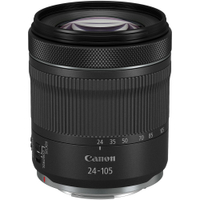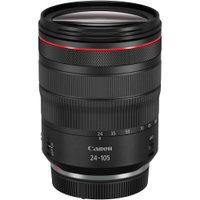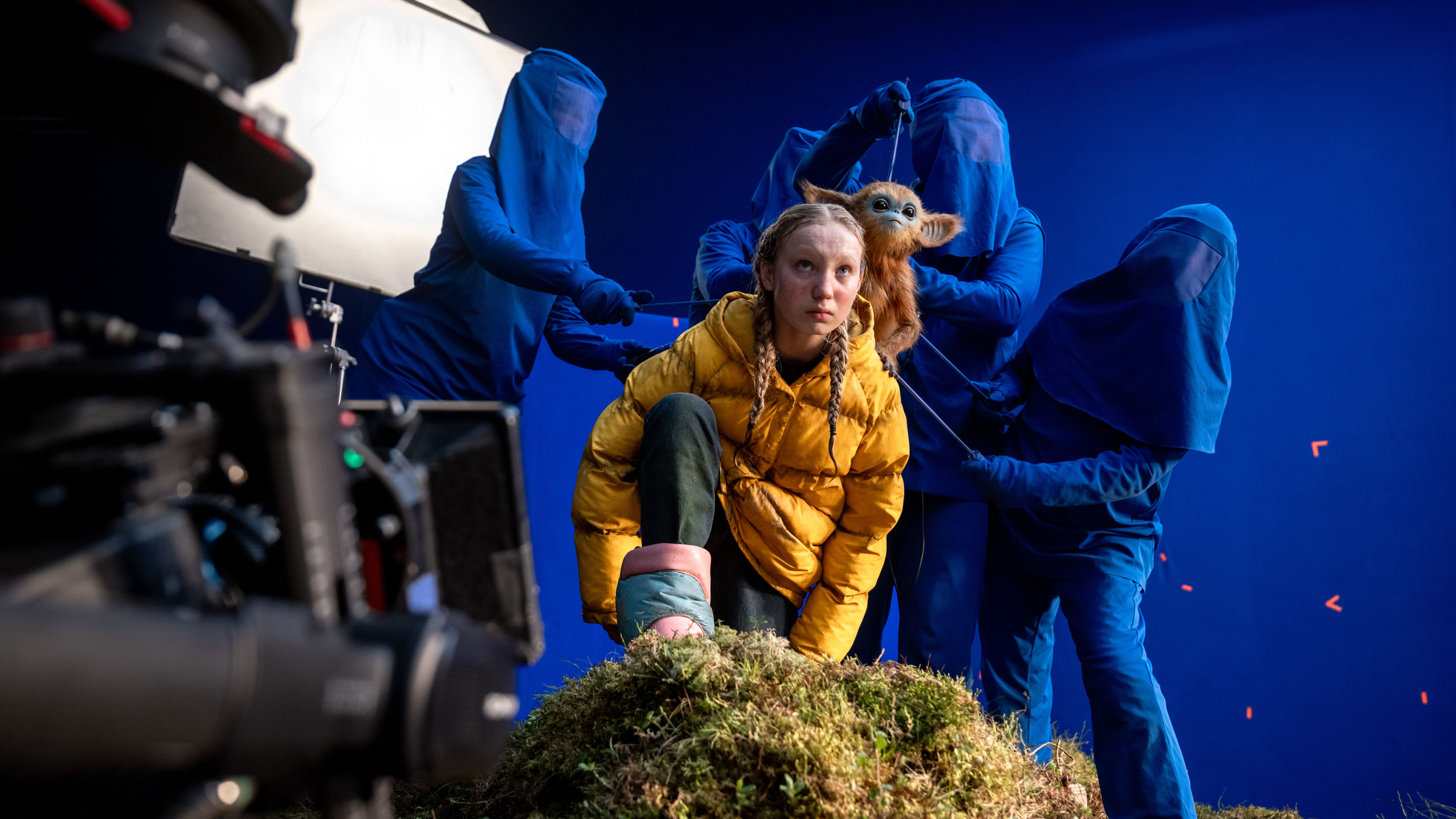Digital Camera World Verdict
I like that the Canon RF 28-70mm f/2.8 IS STM is so compact and lightweight for a standard zoom lens with a relatively fast and constant f/2.8 aperture rating. The main upside for me is a tighter depth of field but, compared with Canon’s RF 24-105mm lenses, but it’s relatively lacking in outright zoom range, at both the short and long ends.
Pros
- +
Constant f/2.8 aperture
- +
Compact and lightweight
- +
Optical image stabilization
- +
Includes weather-seals
Cons
- -
Relatively limited zoom range
- -
No tertiary control ring
- -
Lens hood sold separately
- -
Relies on automatic corrections
Why you can trust Digital Camera World
Canon has RF-mount standard zoom lenses coming out of its ears, making it hard to believe the company has only been making mirrorless full-frame EOS R system cameras and lenses since 2019. The net result from a buying perspective is that it can be hard to choose the one that best suits your needs. Pricing aside, which I’ll come back to presently, options range from the super-tiny RF 24-50mm f/4.5-6.3 IS STM, through no less than three different RF 24-105mm zooms, to relatively ‘fast’ RF 24-70mm f/2.8L IS USM and RF 28-70mm f/2L USM lenses.
The new RF 28-70mm F2.8 IS STM caters to those who want a constant f/2.8 aperture for gaining a tighter depth of field and maintaining fast shutter speeds under low lighting conditions, without suffering the increase in size, weight and expense that this type of lens usually entails. Indeed, I’ve been impressed with similar offerings from other manufacturers, including the Nikon Z 28-75mm f/2.8 and Tamron 28-75mm f/2.8 Di III RXD G2, the latter being available for both Nikon Z and Sony E mount cameras. Back in Canon land, the RF 28-70mm aims to be one of the best lenses for Canon EOS R system cameras.
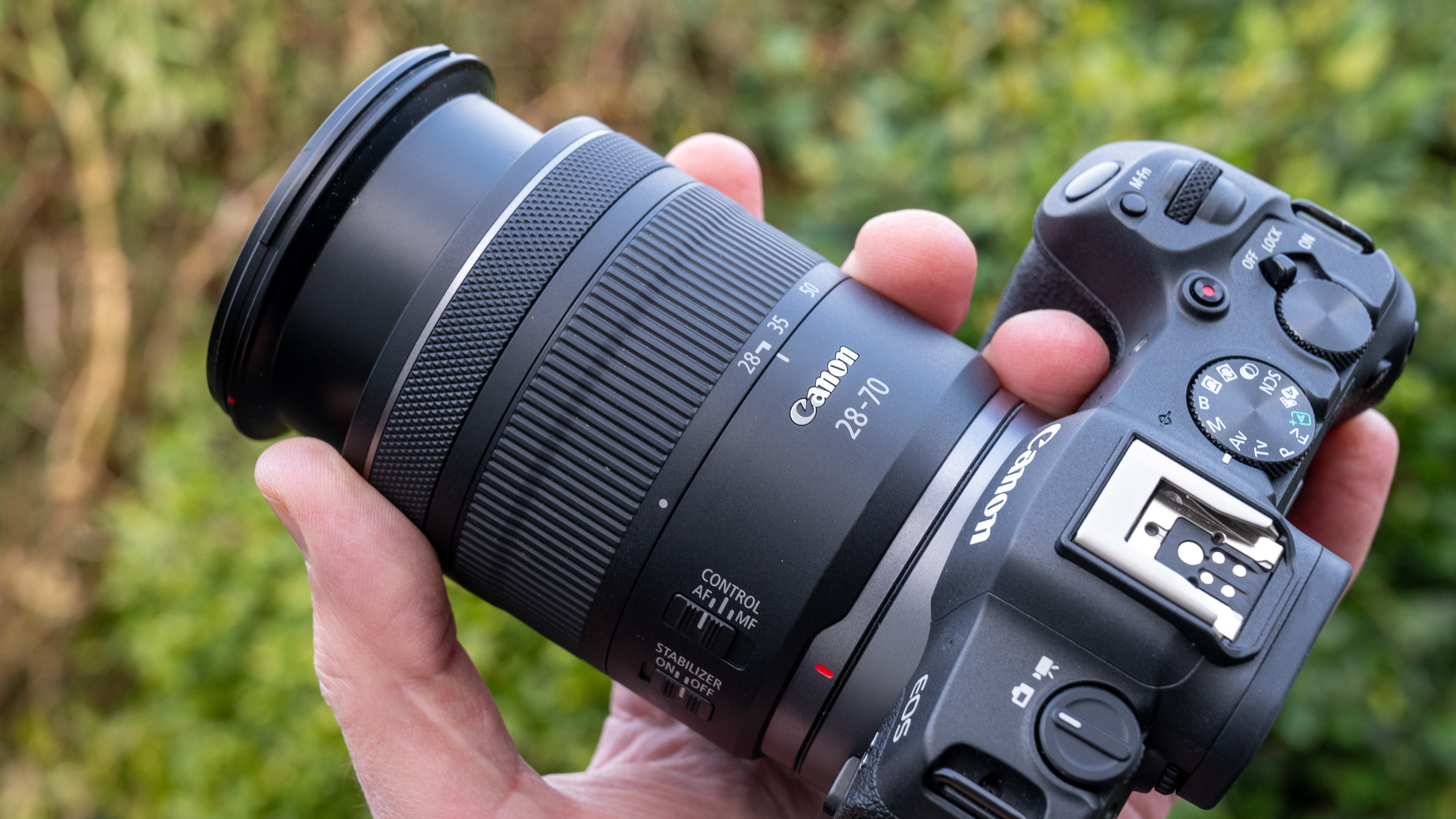
Canon RF 28-70mm f/2.8 IS STM: Specifications
| Mount options | Canon RF |
| Lens construction | 15 elements in 12 groups |
| Angle of view | 75 to 34 degrees |
| Diaphragm blades | 9 |
| Minimum aperture | f/22 |
| Minimum focus distance | 0.27m at 28mm (0.24m MF) |
| Maximum magnification | 0.24x |
| Filter size | 67mm |
| Dimensions | 77 x 92mm / 3 x 3.6" |
| Weight | 490g / 1.1lb |
Canon RF 28-70mm f/2.8 IS STM: Price
The Canon RF 28-70mm F2.8 IS STM isn’t one of Canon’s top-grade L-series lenses and is priced accordingly, at $1099 / £1249 / AU$1919. To give that some perspective, the dinky little RF 24-50mm F4.5-6.3 IS STM costs just $299 / £379 / AU$529, whereas the RF 24-105mm f/4-7.1 IS STM is also much less expensive at $399 / £479 / AU$786. Both of these lenses have significantly slower apertures, especially towards the long end of the zoom range.
Speeding things up and moving into L-series territory, the RF 24-105mm f/4L IS USM comes in at $1299 / £1389 / AU$1949, whereas the faster RF 24-70mm f/2.8L IS USM costs $2199 / £2519 / AU$3848 and the fastest RF 28-70mm f/2L USM costs $2899 / £3299 / AU$4689. There’s also the more specialist ‘hybrid’ RF 24-105mm f/2.8L IS USM Z at $2999 / £3439 / AU$5399. All in all, the RF 28-70mm F2.8 seems a fair price for a lens that aims to give L-series benefits in a more affordable package.
Canon RF 28-70mm f/2.8 IS STM: Design & Handling
If I want a standard zoom lens for everyday shooting, as well as for traveling around, I want it to be reasonably compact, lightweight, and easily manageable. The Canon RF 28-70mm f/2.8 IS STM ticks all of those boxes, with a retractable design that I very much like, as it enables me to pack it away in small spaces. There’s no time nor effort involved in making it ready for use – a simple twist of the zoom ring is all that’s needed, unlike with some retractable lenses that have a fiddly locking button.
Ultimately, the lens folds down to just 77 x 92mm (3 x 3.6") and weighs a mere 490g (1.1lb), which suits me just fine. And sure, the RF 28-70mm f/2L USM is faster and has an identical zoom range, but that’s a relative juggernaut of a lens at nearly three times the weight (1430g / 3.15lb). The words ‘David and Goliath’ spring to mind.

Coming to the lens from the fairly similarly priced RF 24-105mm f/4L IS USM feels like a mixed blessing. Again, the L-series lens offers a constant aperture, albeit one f/stop slower, but I really like that lens’s extra wide-angle and telephoto potential. Switching to the 28-70mm leaves me feeling a little short-changed at both ends of the zoom range.
The upside, naturally, is the faster f/2.8 aperture which enables a tighter depth of field, ideal for blurring the background and isolating subjects within a scene. It’s a classic case of swings and roundabouts, and only you can know whether you’d rather have the extra zoom range or the faster aperture. It depends on what you shoot and how you want to shoot it.
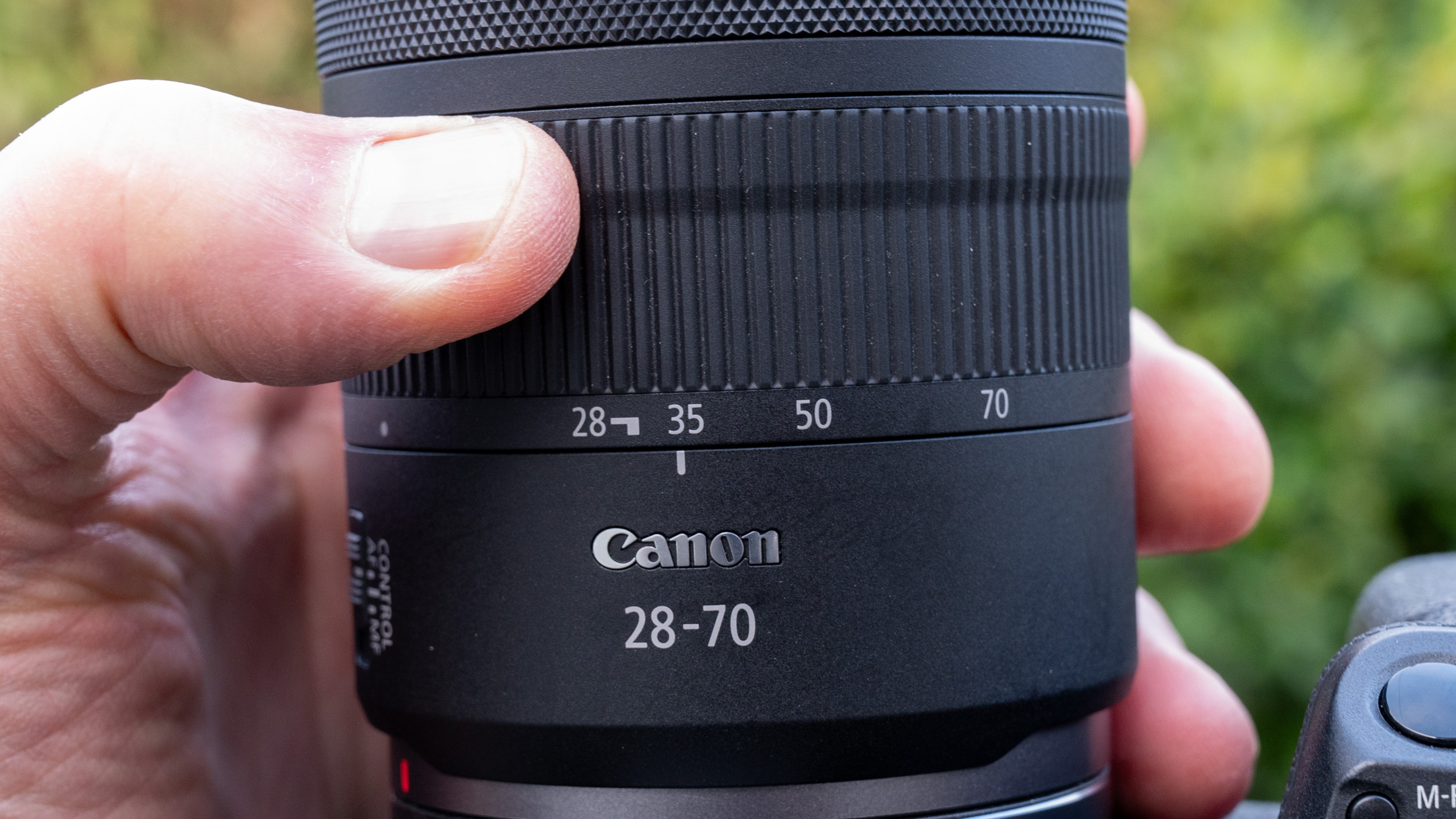
I’m actually testing this lens alongside the Canon RF 16-28mm f/2.8 IS STM wide-angle zoom. They look like almost identical twins, being practically the same size and weight and designed with the same ethos in mind. Both are retractable, look and feel the same, and have the same controls as well as the same diameter filter thread. Controls themselves include an AF/Control/MF switch and a Stabilizer On/Off switch.
With the former, you can choose between autofocus, manual focus or ‘Control’, in which mode the control ring nominally used for manual focusing can take on other functions, like adjusting the aperture, ISO or exposure compensation. It’s a neat trick commonly featured in medium-priced RF lenses, whereas more up-market models have an additional, tertiary control ring.
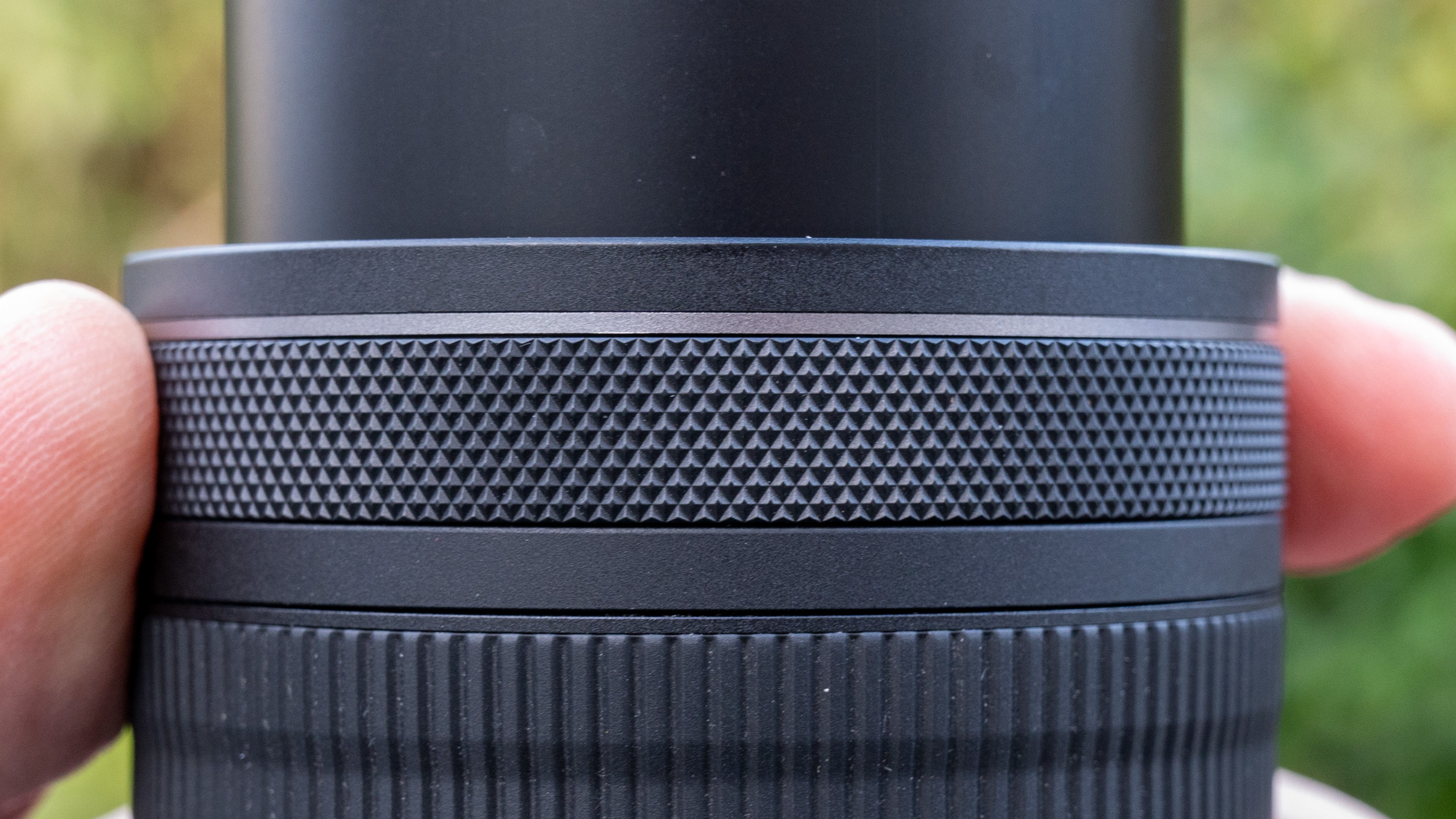
Autofocus is based on a linear stepping motor which is typically quick for stills and smooth for video, with near-silent operation. The lens is also designed to minimize focus breathing for video capture. In the optical stabilization stakes, the stabilizer is claimed to give a 5.5-stop performance in beating camera shake, rising to 7.5 stops when used with EOS R system bodies that feature IBIS (In Body Image Stabilization).
To enhance image quality as well as keep the dimensions and weight to a minimum, the lens features two Glass Molded aspherical elements, along with a pair of UD (Ultra-low Dispersion) elements. Super Spectra coating is applied to combat ghosting and flare.
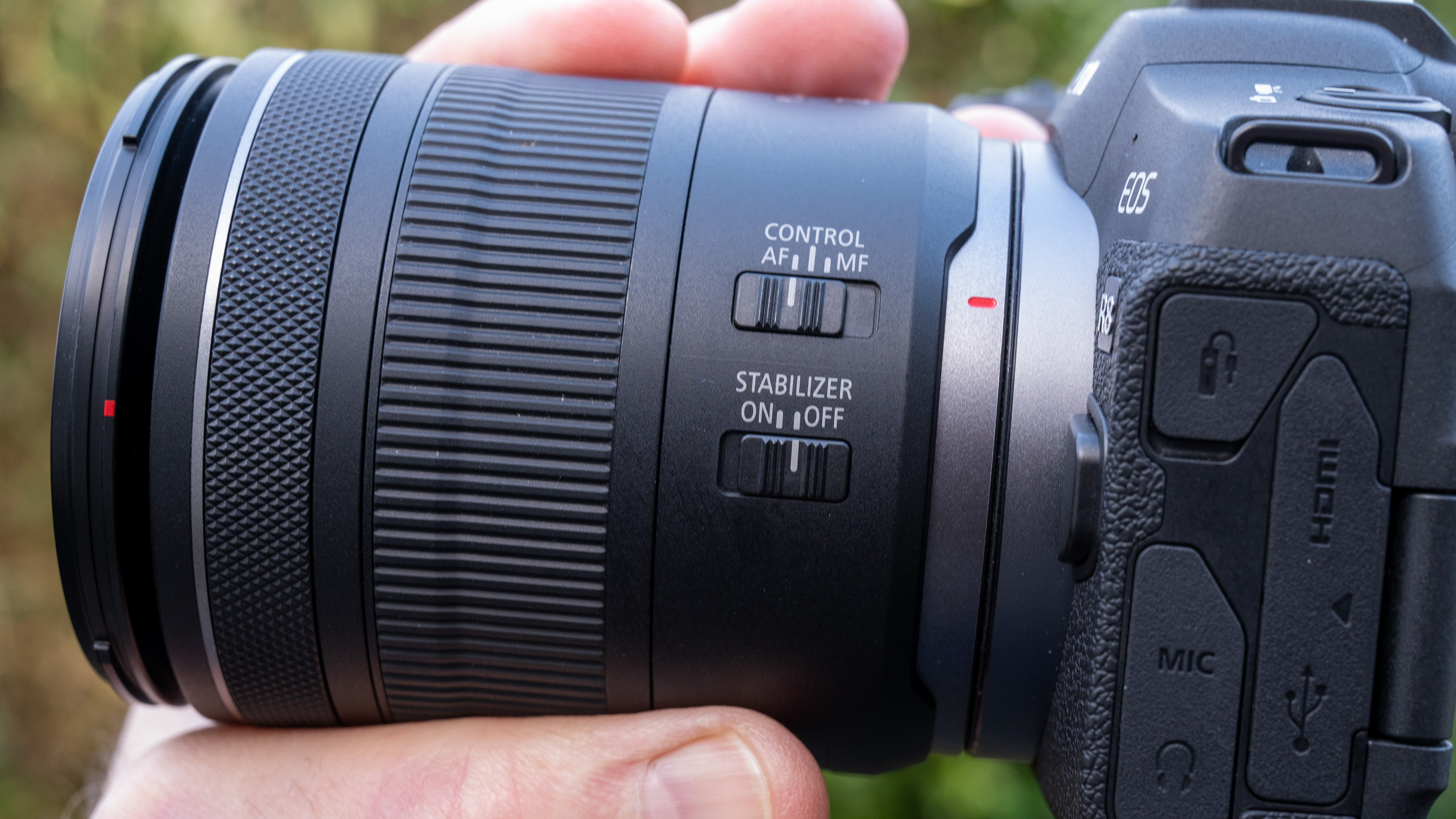
One thing that I think hasn’t come along a moment too soon is that, like the companion RF 16-28mm lens, this one features weather-seals. The sealing isn’t as comprehensive as with most recent L-series lenses but it’s a long awaited step forward for Canon’s mid-range lenses.
As such, the lens features a rubber gasket on its metal mounting plate and additional seals around joints in the barrel, but not behind the control switches. In less impressive news, the lens continues the age-old tradition of non-L-series Canon lenses being sold without lens hoods. In this case, the EW-73D hood will set you back an additional $35/£48/AU$58.
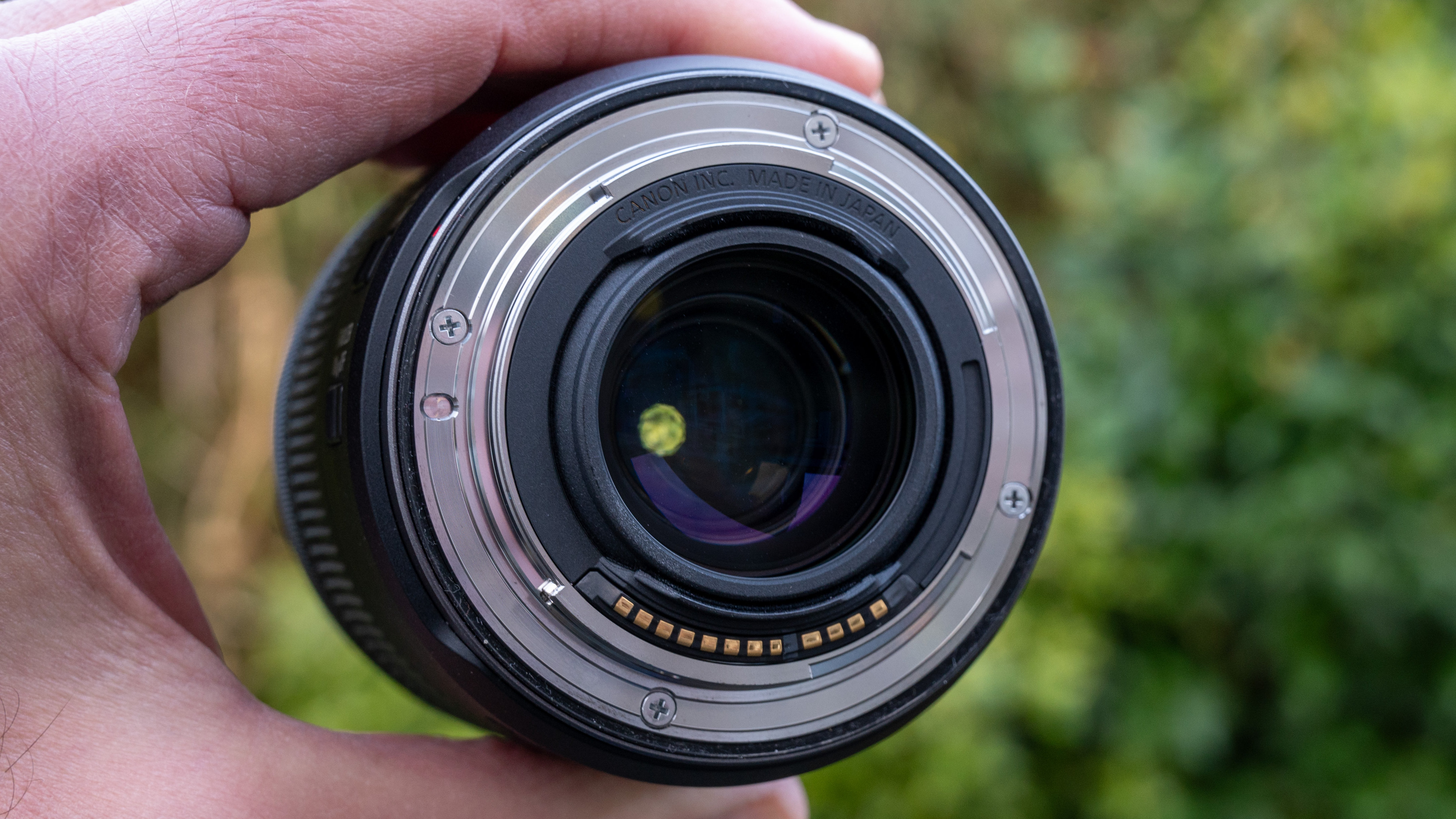
Canon RF 28-70mm f/2.8 IS STM: Performance
Sometimes one is never enough and twice as much is twice as good. I feel that the RF 16-28mm and 28-70mm lenses go so well together that I wish Canon offered them as a pair with an attractive price discount incentive. The size, weight and handling characteristics are virtually identical and the zoom range of each lens picks up seamlessly from the other. Even so, the RF 28-70mm has a lot to offer on its own.
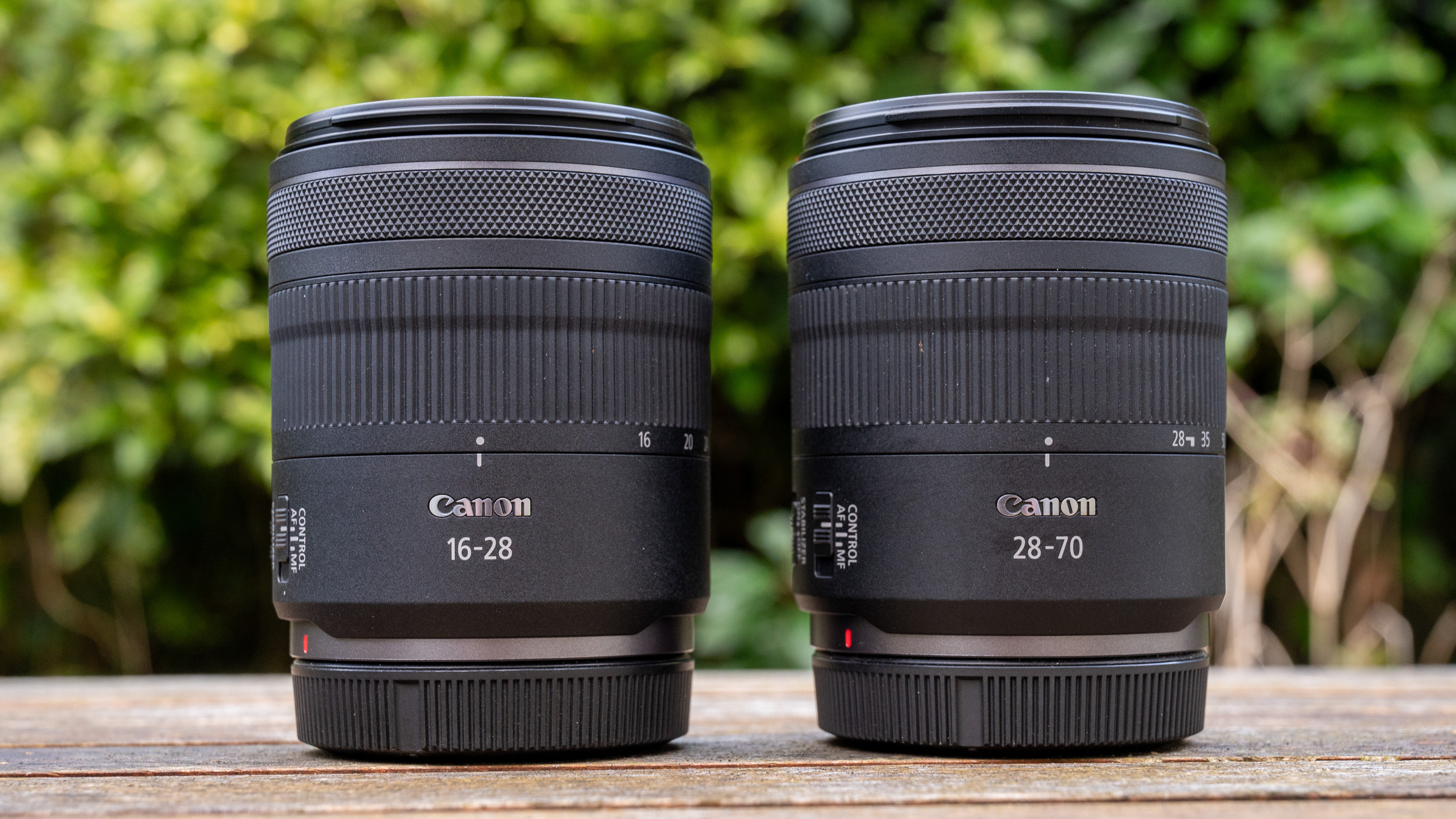
Autofocus is as quick for stills and as smooth for video as I was expecting from the linear stepping motor system. As for optical stabilization, I found I could comfortably get 4.5-stop effectiveness when testing the lens on a Canon EOS R8, which lacks IBIS. That doesn’t quite live up to Canon’s 5.5-stop promise but I personally find I often struggle to match the claims that are bandied about these days for stabilization performance in handheld shooting.
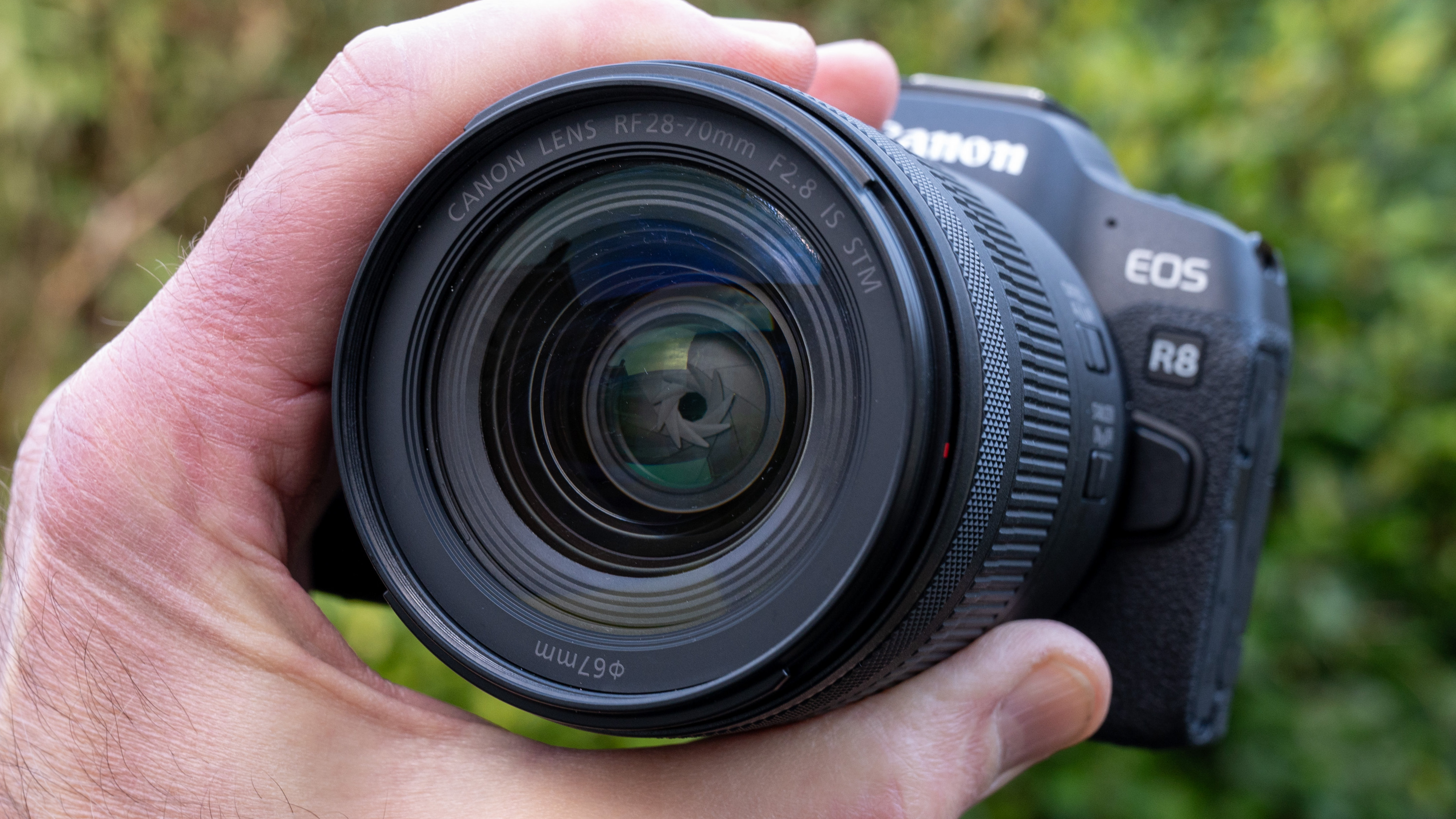
Levels of center-sharpness are fabulous throughout the entire zoom range, even when shooting wide-open at f/2.8. At most zoom settings, it pays to stop down to apertures of between f/4 and f/11 for the best sharpness away from the central region of the frame. Extreme edge/corner-sharpness is impressive throughout most of the zoom range, only dropping off to still fairly decent levels at the longest focal length of 70mm.
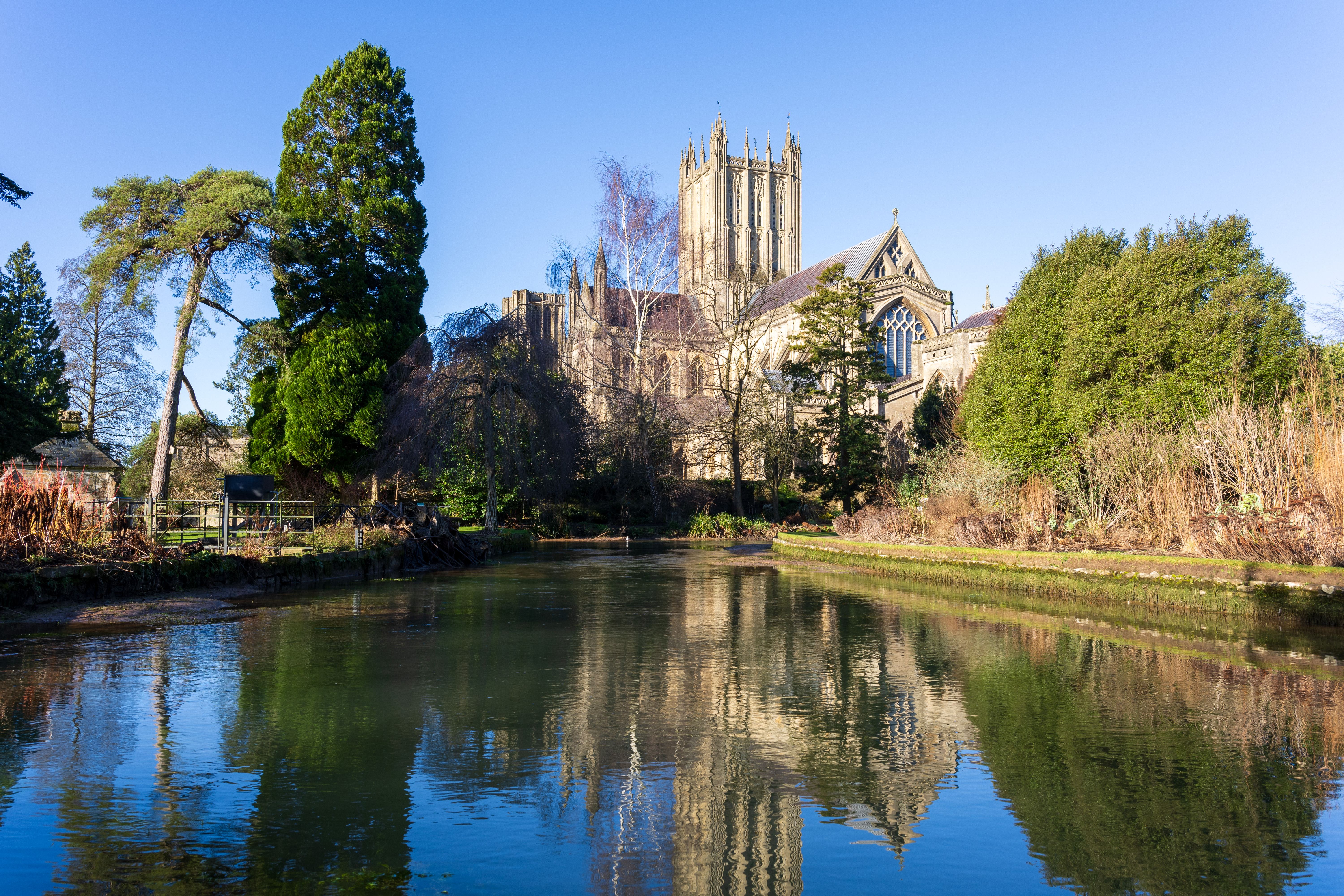
Color fringing is well controlled but can be slightly noticeable when uncorrected, mostly out at the edges and corners of the image frame. If you want your lenses to be compact and lightweight, something has to give and the trade-off is generally in distortion and vignetting. This lens follows the current vogue, relying heavily on automatic in-camera correction for distortion which can’t be disabled in the menu system of the host camera body. Without it, barrel distortion is pretty extreme at 28mm, and there’s heavy pincushion towards the longest zoom setting. It’s a price I’m more than happy to pay. I actually like the option for switching correction for ‘peripheral illumination’ on or off, as I think vignetting can add a pleasing creative element to some shots, so it's nice to have the choice.

One of the main selling points of a standard zoom with a comparatively fast and constant f/2.8 aperture is that it can deliver a tighter depth of field. The RF 28-70mm does well to combine good sharpness where I want it, along with smooth bokeh in defocused areas. Bokeh fringing (axial chromatic aberration) is also minimal. This can often be a problem for ‘fast’ lenses, more especially for even faster primes, rearing its ugly head as color fringing around high-contrast transitions just in front of or behind the plane of focus.
Canon RF 28-70mm f/2.8 IS STM: Sample Images
The following gallery of sample images was shot in the English city of Wells, in Wells Cathedral and at the adjacent Bishop’s Palace Garden. There’s a mix of low-lit interior shots and sunny-day exteriors, captured at various zoom settings and apertures.
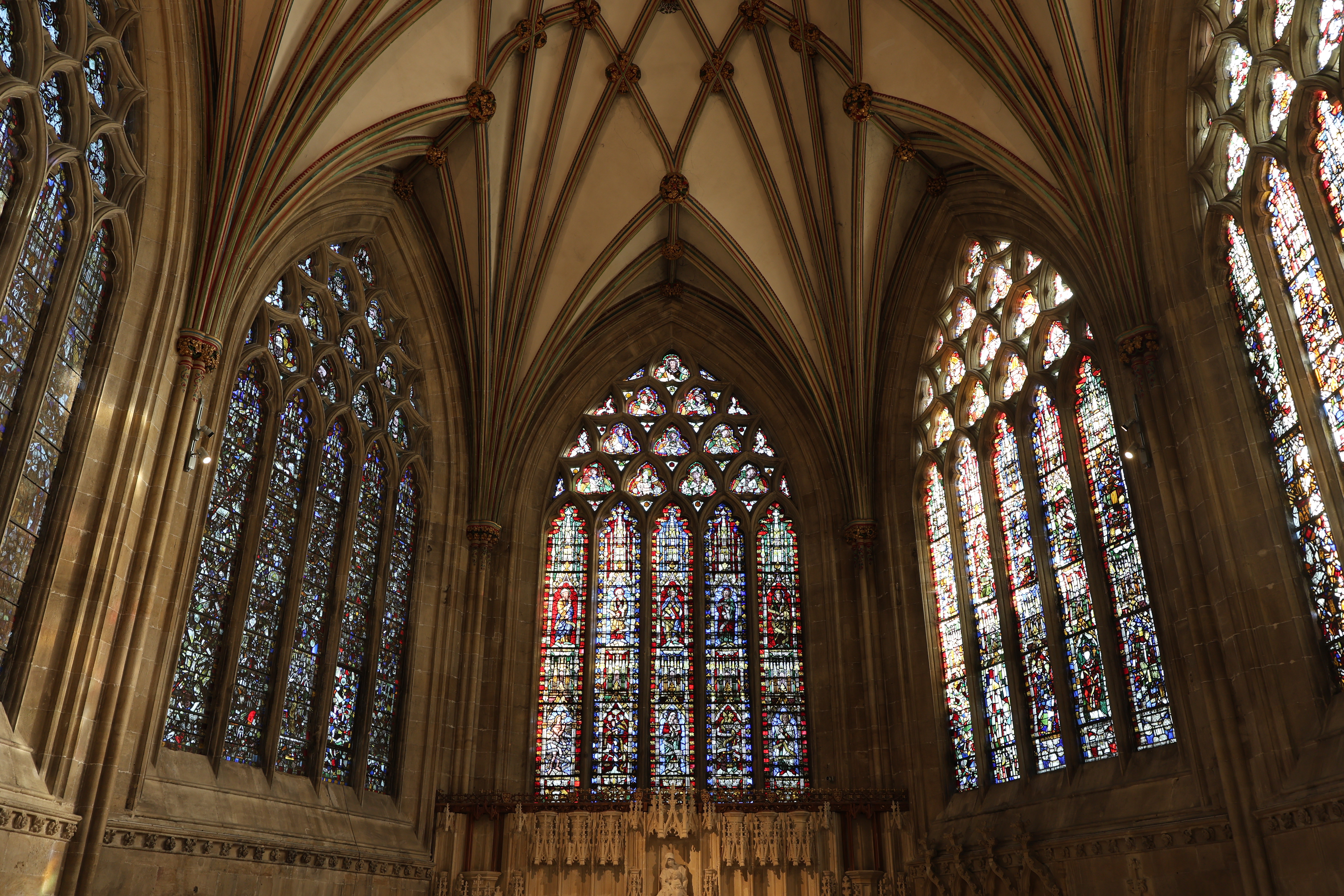

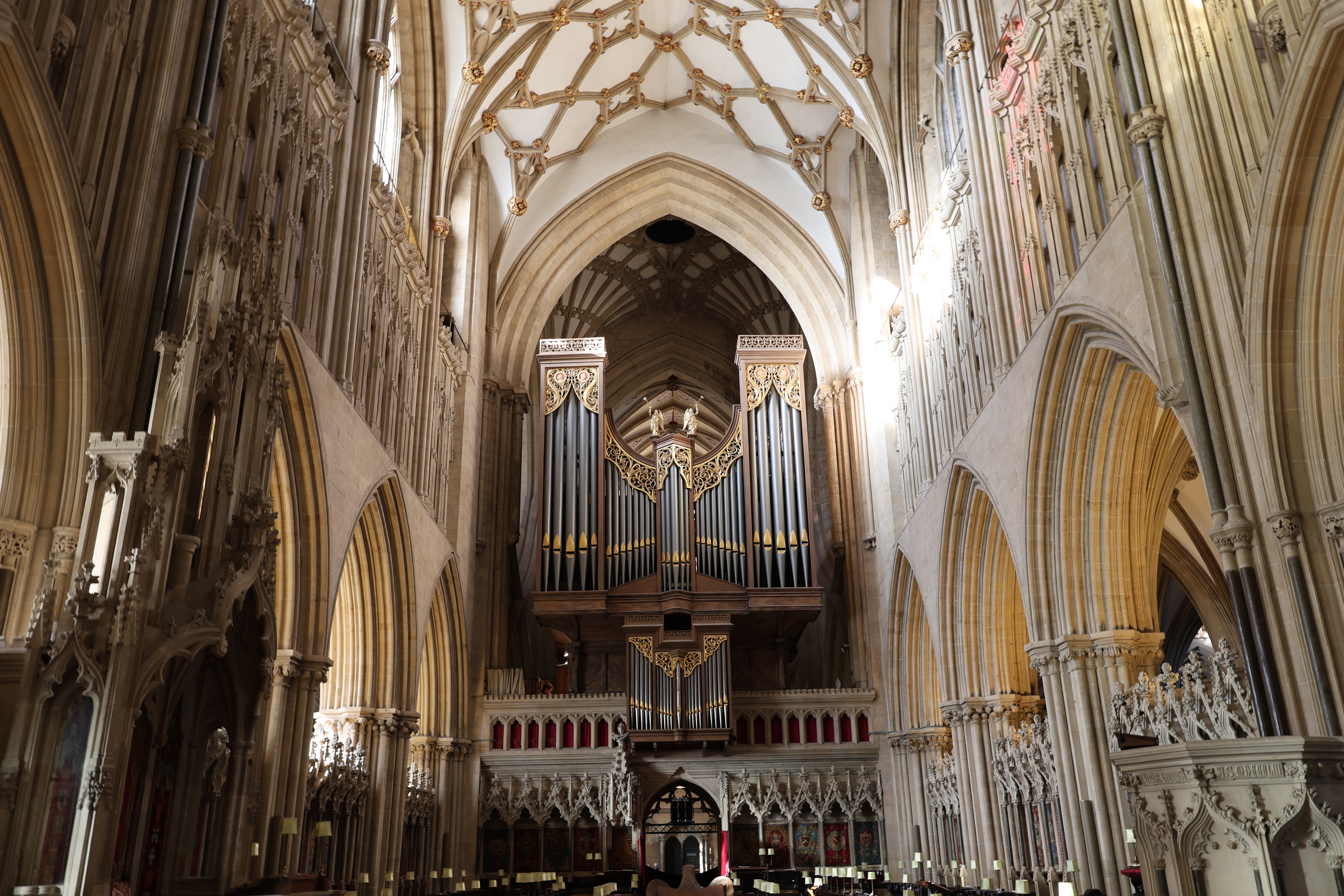

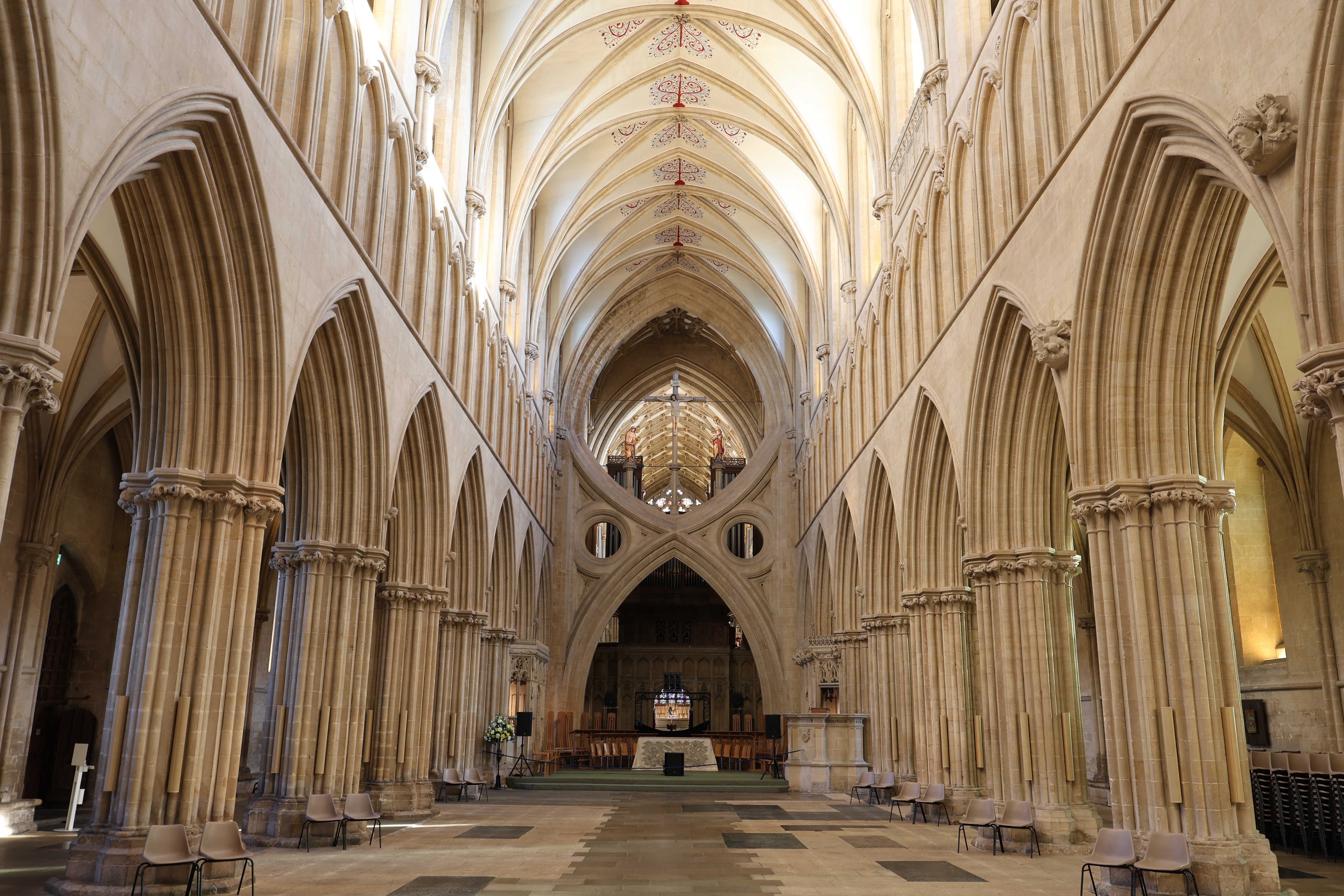
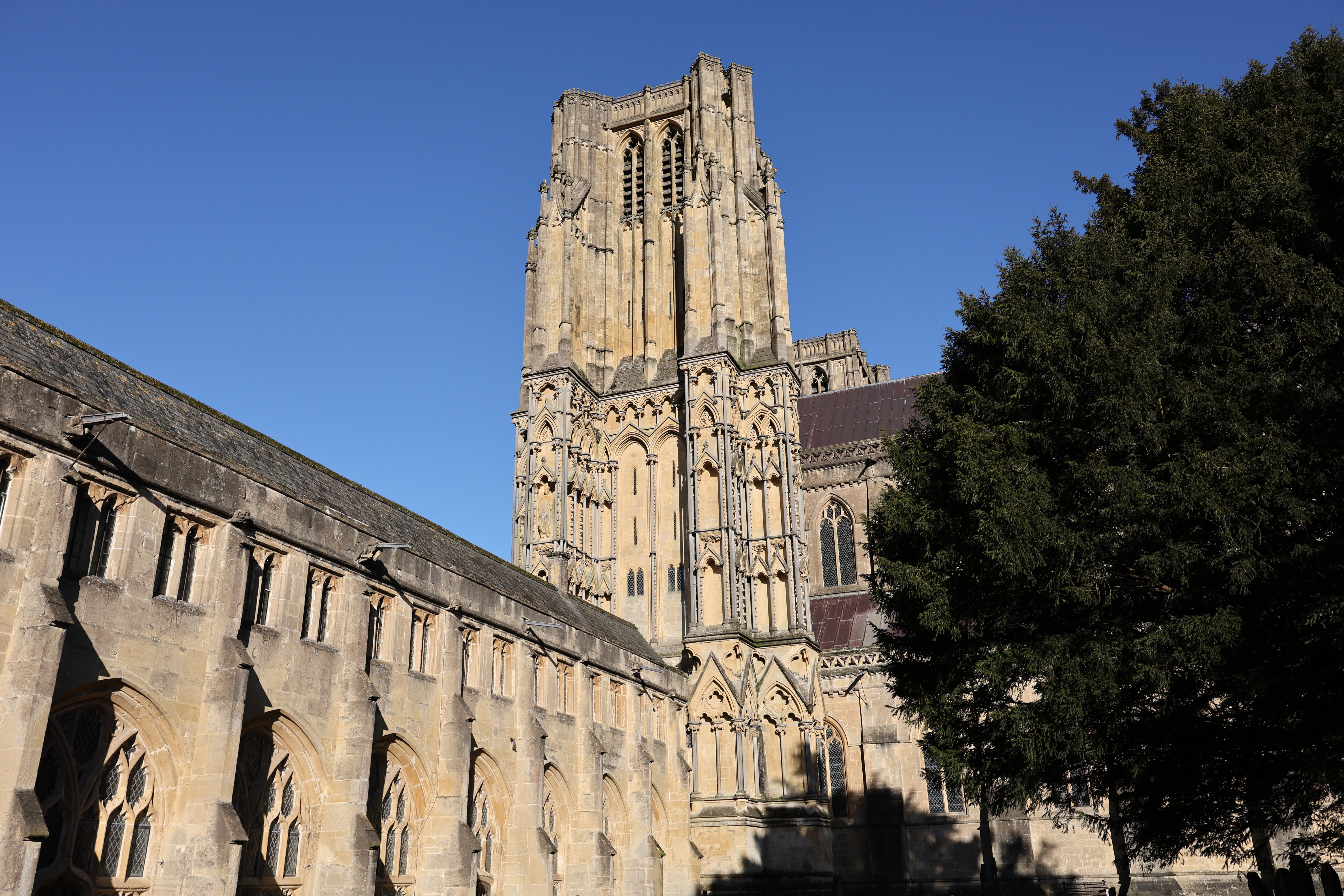
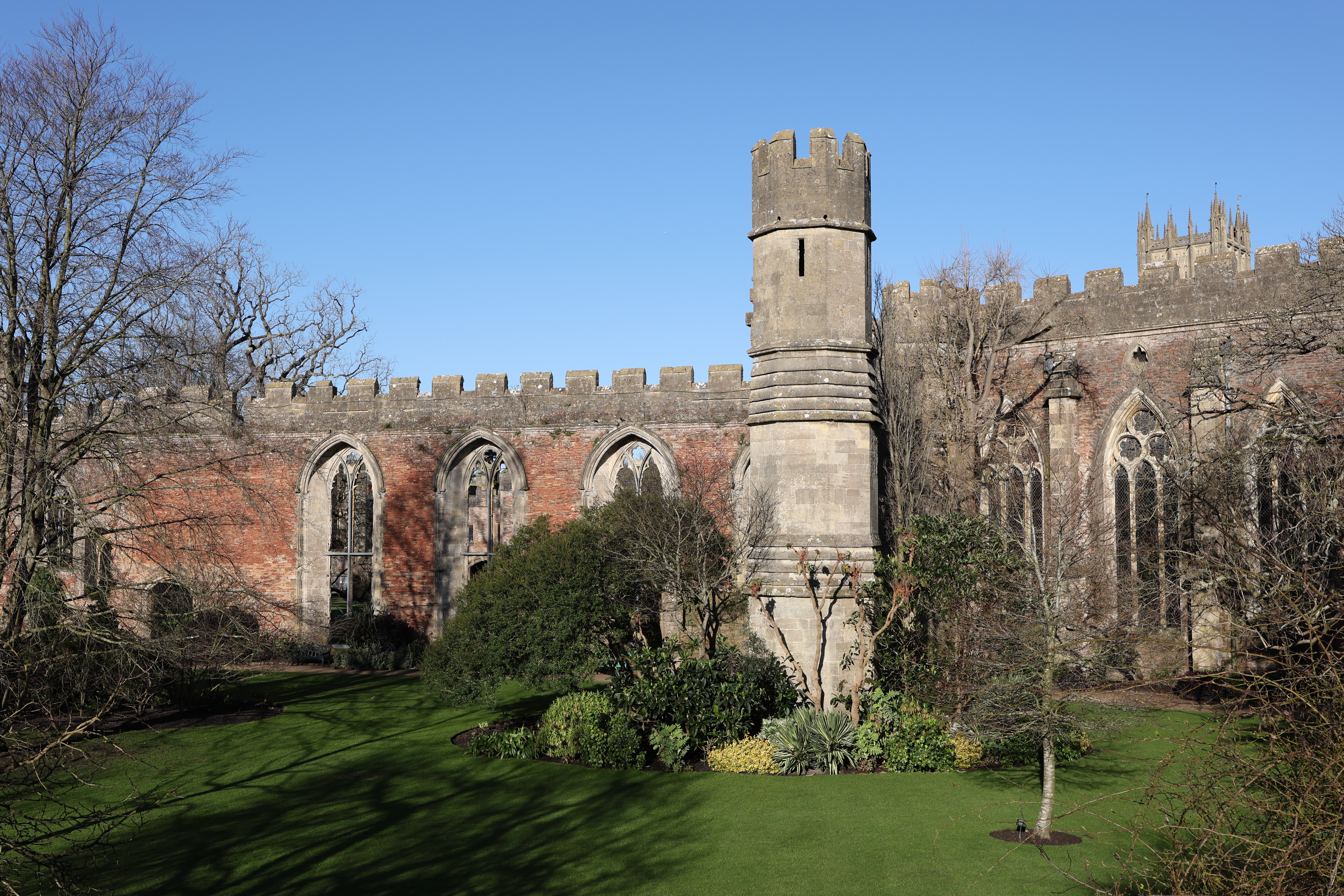


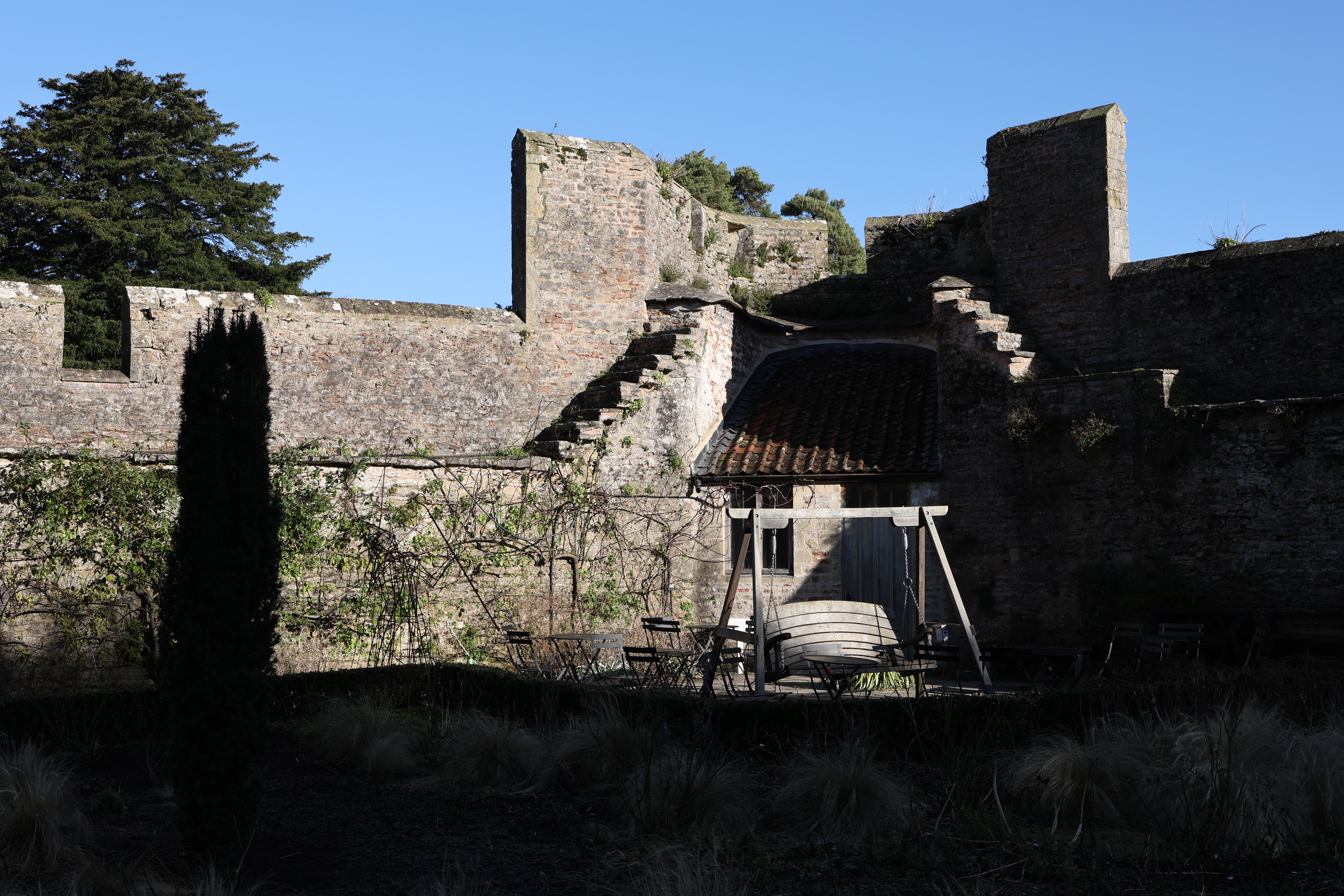




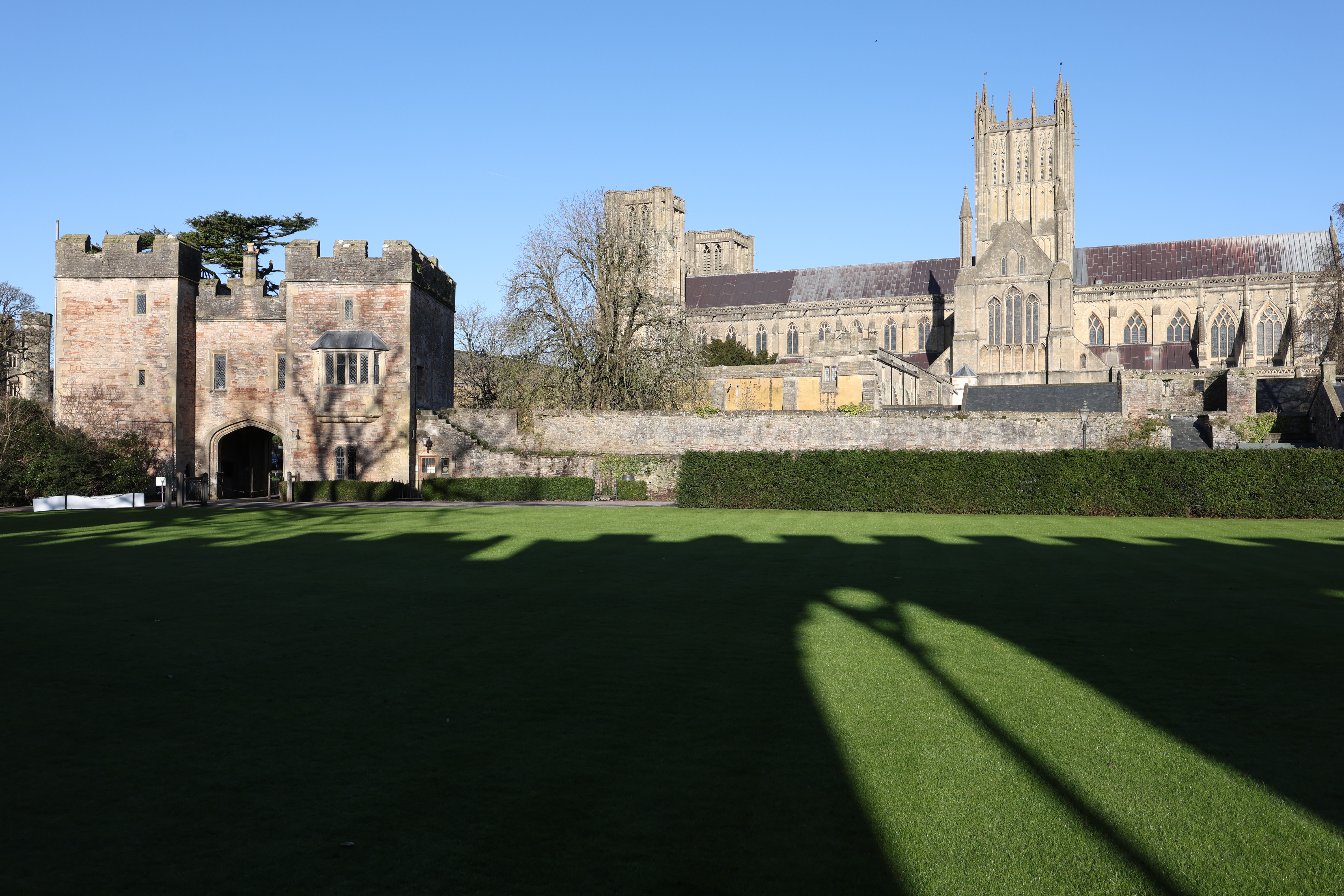
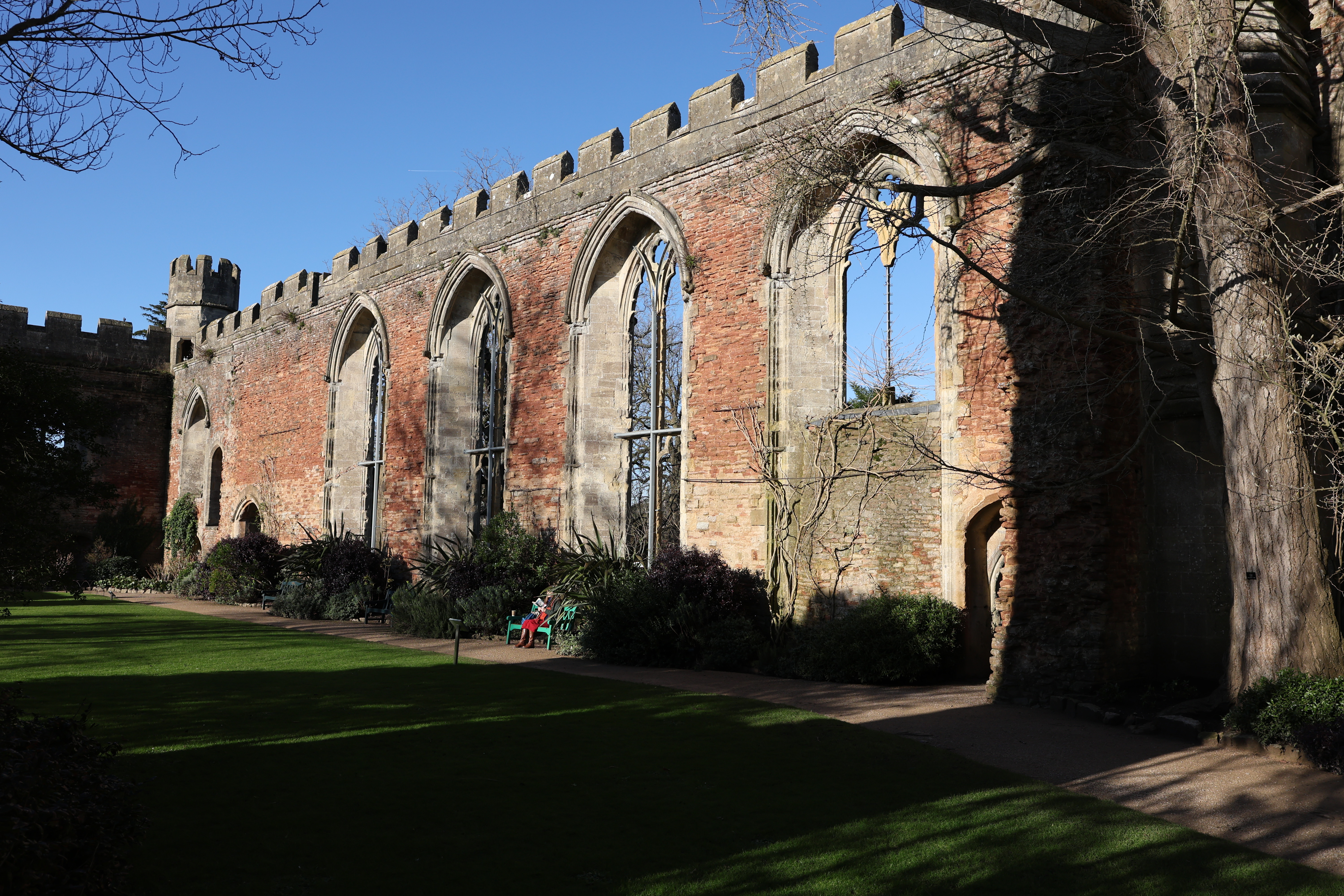
Canon RF 28-70mm f/2.8 IS STM: Lab Results
We run a range of lab tests under controlled conditions, using the Imatest Master testing suite. Photos of test charts are taken across the range of apertures and zooms (where available), then analyzed for sharpness, distortion and chromatic aberrations.
We use Imatest SFR (spatial frequency response) charts and analysis software to plot lens resolution at the center of the image frame, corners and mid-point distances, across the range of aperture settings and, with zoom lenses, at four different focal lengths. The tests also measure distortion and color fringing (chromatic aberration).
Sharpness:
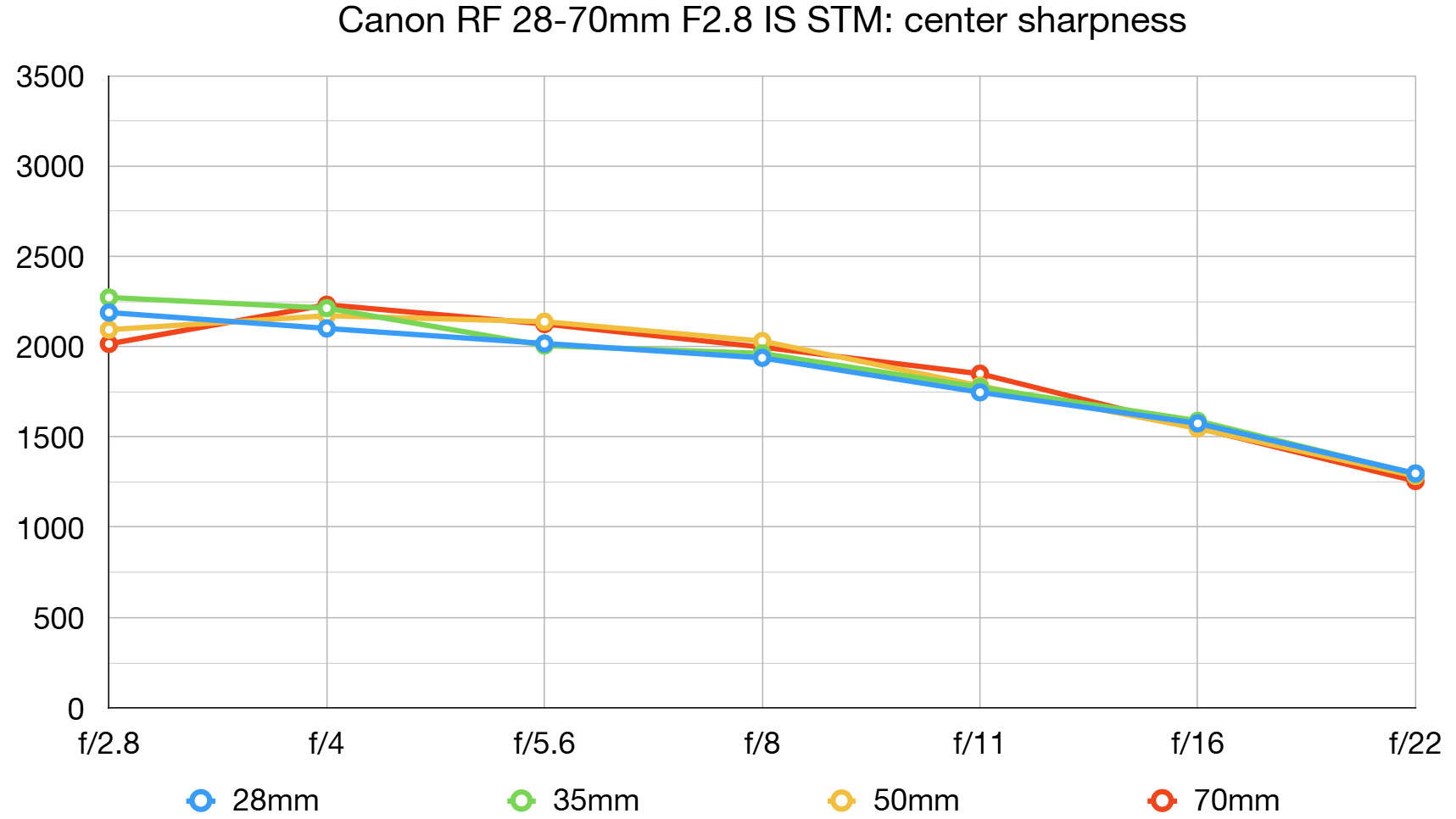
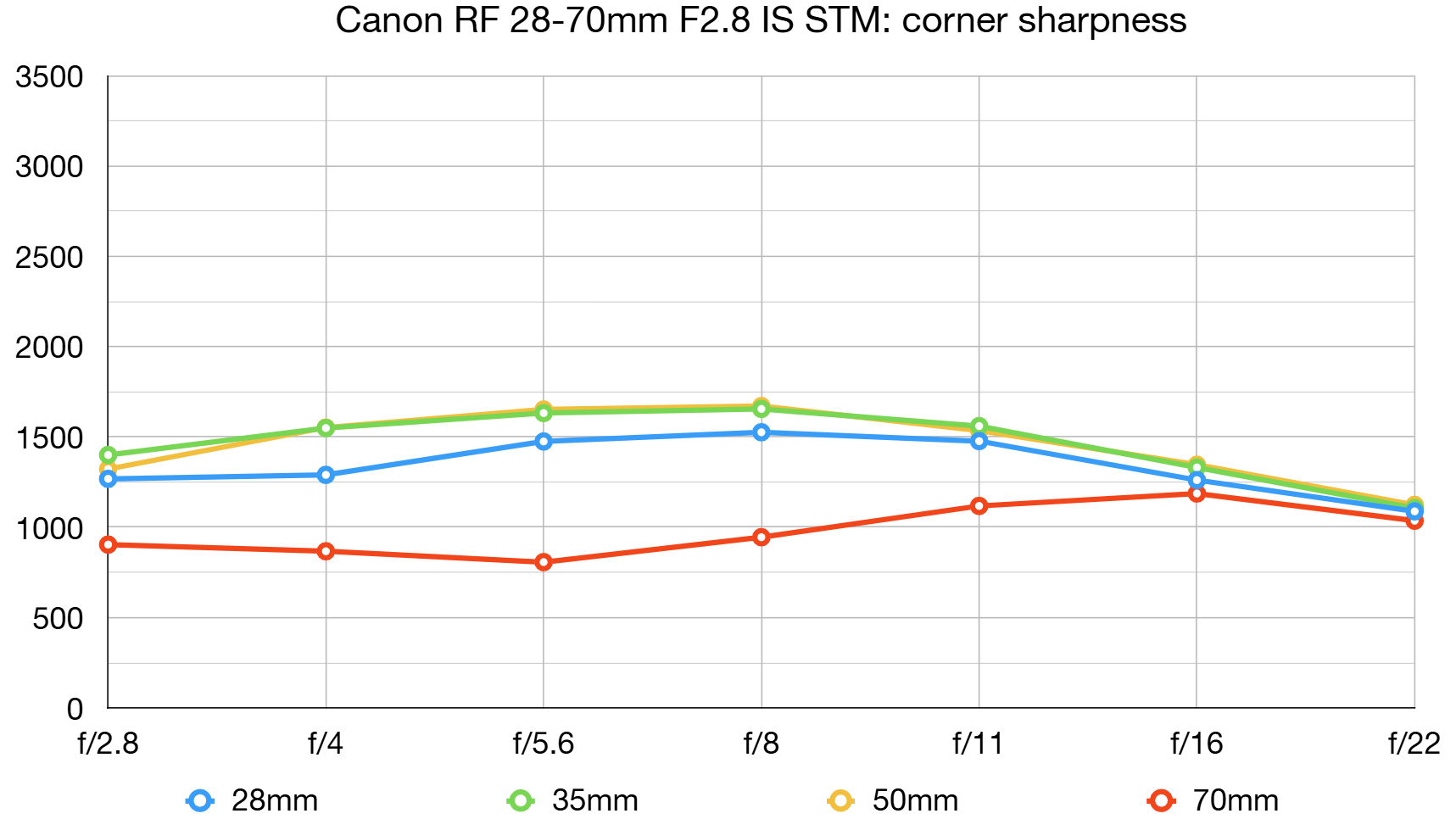
Center-sharpness is excellent from the get-go, wide open at f/2.8, throughout the entire zoom range. Away from the center, it pays to stop down to apertures of between f/4 and f/11 for optimum sharpness. Levels of sharpness at the extreme edges and corners of the image frame are generally very impressive, only dropping off at the longest zoom setting of 70mm.
Fringing:

Color fringing can be a little noticeable towards the edges and corners of the image frame, peaking at focal lengths around 28mm and 50mm. As with distortion, automatic in-camera correction is available but this time its use is optional rather than compulsory.
Distortion:
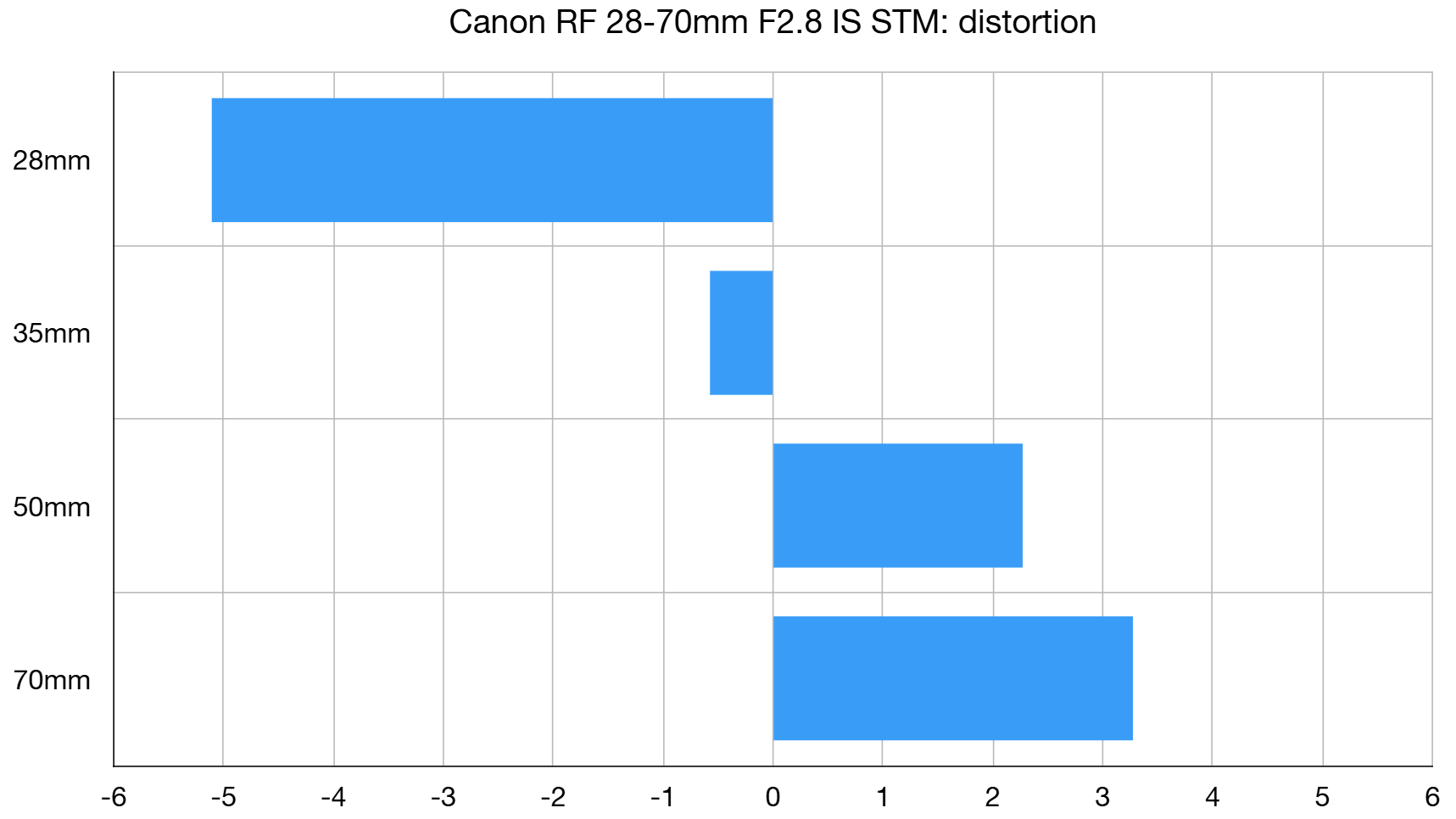
There’s hefty barrel distortion at 28mm, very little at 35mm, and noticeable pincushion at 50mm becoming worse at 70mm. That’s pretty much as expected for a modern lens for mirrorless cameras, with compactness and light weight being high on the list of design criteria. Automatic in-camera correction applies the necessary fix and can’t be switched off in the menu system.
Canon RF 28-70mm f/2.8 IS STM: Verdict
I feel that the Canon RF 28-70mm f/2.8 IS STM is an ideal ‘everyday lens’, being much more compact and lightweight than typical ‘trinity’ standard zooms. It’s a tough call though, whether the faster aperture makes the reduced zoom range worthwhile, compared with the RF 24-105mm f/4L IS USM which gives more expansive wide-angle coverage and considerably longer telephoto reach. It all depends on whether I want the faster f/2.8 aperture for a tighter depth of field and quicker shutter speeds under dull lighting conditions. The jury’s still out on that one. Either way, I like that that the RF 28-70mm is reasonably priced and that, unlike most non-L-series Canon lenses, it features weather-seals. But for goodness sake Canon, just throw in the lens hood as part of the deal instead of charging me extra for it.
| Features | Appealing features include linear stepping motor autofocus, optical stabilization and a fast and constant f/2.8 aperture. | ★★★★★ |
| Design | What’s not to love about a retractable design? I do like being able to stow lenses away in small spaces and I also like the weather-sealed build. | ★★★★★ |
| Performance | It’s mostly excellent but as is often the case, this ‘mirrorless’ lens relies quite heavily on in-camera corrections. | ★★★★ |
| Value | It’s good value but similar lenses from the likes of Nikon and Tamron are rather less expensive to buy. | ★★★★ |
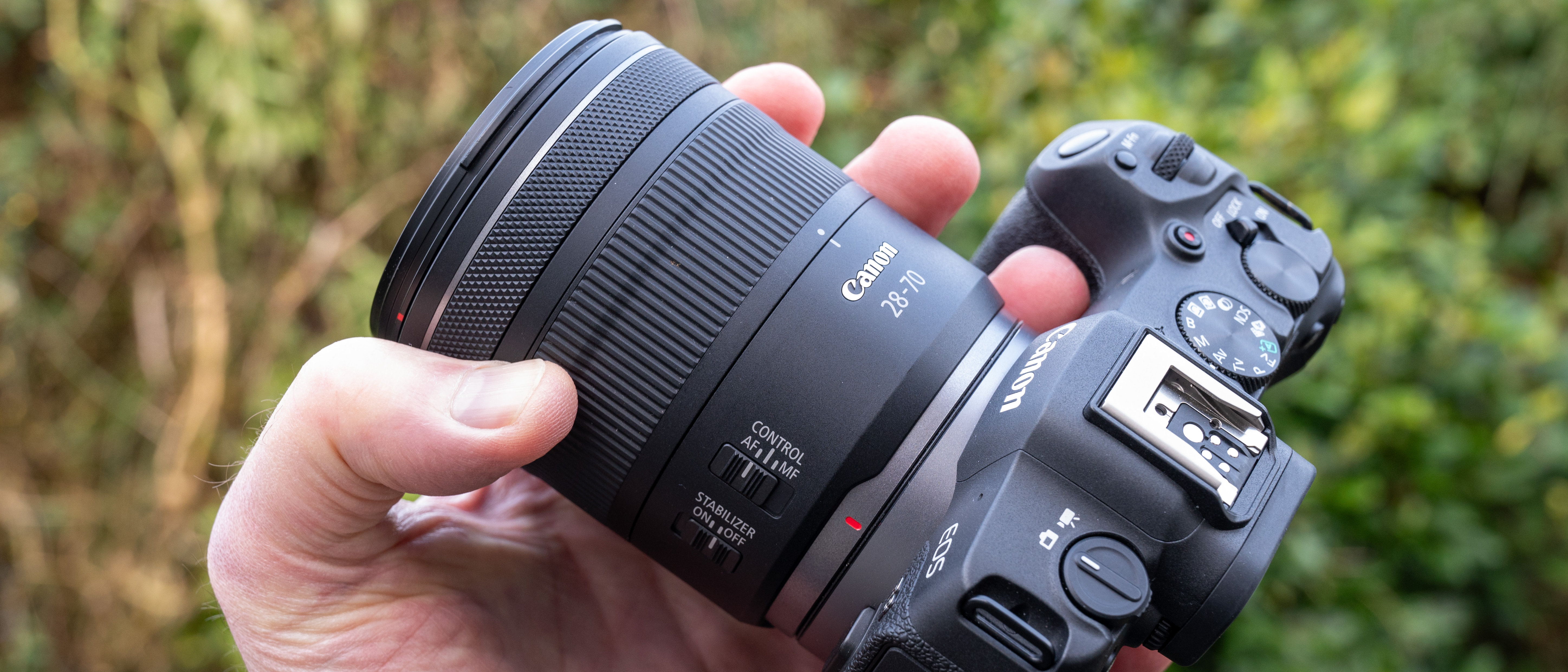
Alternatives
The Canon RF 24-105mm f/4-7.1 IS STM is much less expensive at $399 / £479 / AU$786. It has a variable rather than constant aperture rating, and is much slower towards the long end of the zoom range, but is similarly compact and lightweight, and adds a neat macro facility.
The Canon RF 24-105mm f/4L IS USM is a properly high-end L-series lens that’s keenly priced at $1299 / £1389 / AU$1949. It’s only an f/stop slower than the RF 28-70mm but has a much more extensive zoom range, from more expansive wide-angle coverage to greater telephoto reach.
Matthew Richards is a photographer and journalist who has spent years using and reviewing all manner of photo gear. He is Digital Camera World's principal lens reviewer – and has tested more primes and zooms than most people have had hot dinners!
His expertise with equipment doesn’t end there, though. He is also an encyclopedia when it comes to all manner of cameras, camera holsters and bags, flashguns, tripods and heads, printers, papers and inks, and just about anything imaging-related.
In an earlier life he was a broadcast engineer at the BBC, as well as a former editor of PC Guide.
You must confirm your public display name before commenting
Please logout and then login again, you will then be prompted to enter your display name.

